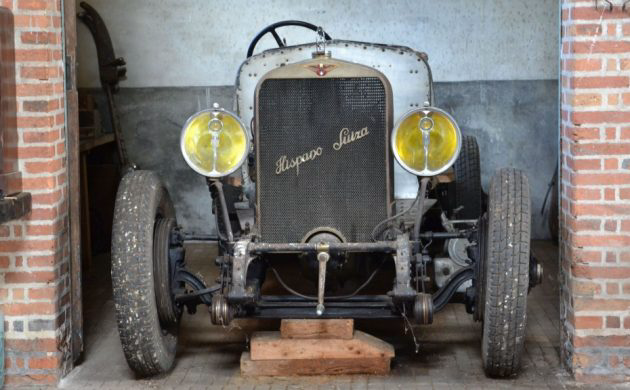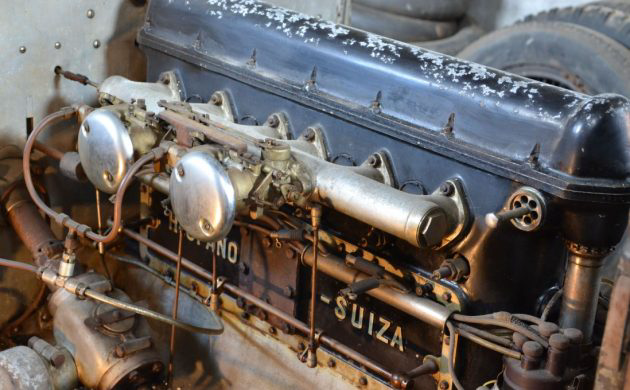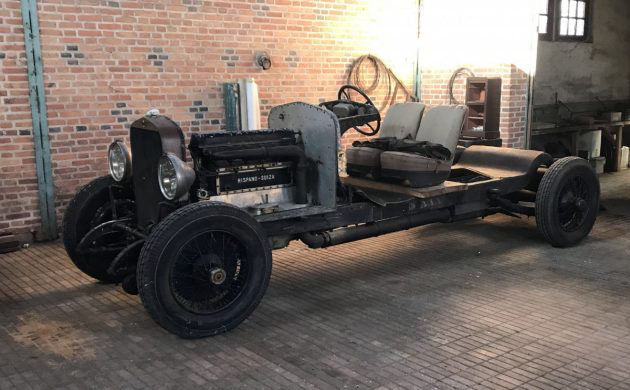Same Family Since ’25: 1924 Hispano-Suiza H6B
There are barn finds and then there are rediscovered treasures of art and engineering– treasures like this 1924 Hispano-Suiza H6B. This interwar classic is listed here on Artcurial, lot 108 in an auction concluding on March 18. Although the sale will take place in Paris, it’s not clear where the car itself is located. Interested parties should contact the company, though they should also pack their checkbook: the car is expected to fetch between 80,000 and 140,000 euros (roughly $90,000 to $158,000). With a machine this rare and in such a perfect state of preservation, though, it’s anyone’s guess as to where the bidding will end.
American readers might not be terribly familiar with Hispano-Suiza. The company was founded in Barcelona near the turn of the 19th century, but expanded to include manufacturing throughout Spain as well as an increasingly profitable French factory. Only a year before this car was built, the French business incorporated, with the Spanish parent company retaining a controlling share. Early automotive offerings were successful, but the firm cemented its engineering reputation during the First World War with a series of groundbreaking aircraft engines. Through the Thirties the French and Spanish branches of the company would remain involved in aeronautics, and while the Iberian enterprise would fold in the years following the Spanish Civil War, the French company is still active in the aerospace sector.
The experience of Hispano-Suiza in the field of aviation had an immediate impact on the development of the H6: the cast aluminum block of its overhead cam straight-six was derived from one bank of the company’s V12 aircraft engine. Equipped with an overhead cam and displacing 6.6L (403 cubic inches), the factory claimed that the monster six made 135 brake horsepower, though later writers have suggested that the engine might actually be a little less powerful than advertised. Torque is in ample supply, enabling the car to easily remain in top gear at all but the slowest speeds. Second gear would be used rarely, and first almost never.
This H6B was originally a dual-cowl phaeton, though it was at some point re-bodied as a cabriolet. Artcurial suspects that the original coachwork might have been done by the famous Carrosserie Millon-Guiet in Paris, though this hasn’t been verified. The car was disassembled prior to the start of the Second World War for another renovation, but this proved to be the last time it would be in one piece. The owners report that it was last driven in the Sixties– after this, it was placed in storage, with great care taken to protect the valuable (and likely irreplaceable) components. This included coating the metal in paraffin wax and regularly turning the engine to ensure that it spun freely. This attention to detail and careful conservation paid dividends, resulting the fantastically preserved machine we see in these photos. Although the new owner will doubtless pursue a full restoration, it will be only the latest chapter in the long and interesting history of this magnificent automobile.
Auctions Ending Soon
 2002 Subaru Impreza WRXBid Now2 days$333
2002 Subaru Impreza WRXBid Now2 days$333
 1975 Chevrolet Corvette ConvertibleBid Now2 days$4,000
1975 Chevrolet Corvette ConvertibleBid Now2 days$4,000
 1964 Ford F-100 Camper CustomBid Now2 days$2,000
1964 Ford F-100 Camper CustomBid Now2 days$2,000
 2006 Jeep Wrangler SportBid Now4 days$10,500
2006 Jeep Wrangler SportBid Now4 days$10,500
 1974 Datsun 260ZBid Now6 days$750
1974 Datsun 260ZBid Now6 days$750





Comments
Same family from new, older photos and a carte grise; there’s the possibility that, somewhere in the house, the car’s build sheet/original order survives. It sounds like the car’s in an old French country house.
I would imagine that a family that obviously prized this car as they have must have included it in family photos. All that would be needed then is an expert English wheel operator.
Hmmmm, great writeup, but perhaps “near the turn of the 19th century” should have been “near the turn of the 20th century”. It was 1904 I believe.
No doubt it’s a cool and even important car, but “perfect state of preservation” is nowhere close to reality.
29,000 kilometers showing on the odometer, and no wear on the clutch and brake pedals. It’s unclear, but I guess the body is not around. Amazing that the radiator mascot is still with the car.
It would be neat to fix and drive as is, but if you’re going to add a body, you may as go all the way.
My father was a farmer in the 50s 60s 70s and 80s in central California. His good friend was also a farmer. That man made a boatload of money growing fresh market tomatoes that shipped all over the United States. He amassed a sizable car collection. There was an HS 6 in that collection that he found in the California coast range between Monterey and Hearst Castle at the 3000 foot level parked under some redwood trees. He sent it to Europe for restoration and three years later brought it back and took Pebble a couple of times. He did the same with his 36 Packard convertible. As a young teen I wandered through his large steel tomato shed many a time and looked at all of his cars.:..he used to let me sit in anyone I wanted. That changed my life.
I saw a few of these at the weekend at a car show in Madrid, all magnificently different coachbuilds, from sports to limo. This example would have to have a sporting body, much less expensive to achieve- and more exciting!
Hispano-Suiza is a great marque, whose history mirrors that of 20th Century Spain. Not good…….. Your write-up is fairly good at telling a complicated story. The Paris factory was opened because of the increasing insecurity in Spain, which eventually erupted into the Spanish Civil War.
Although many outside Spain may think of Hispano as a French marque, all the capital was Spanish and the products were designed in Spain, being renowed for their quality and performance. Maybe we should say Catalunia, as it is in Barcelona where the Spanish car and motorbike industry developed almost exclusively.
The Spanish Hispano-Suiza factory and its skilled workforce provided the nucleus of the facilities of Franco´s Pegaso post WW2 project. Said expertise also benifitted the inaugaration of post war Spanish car mass manufacturer SEAT- also based in Barcelona.
Good comments, Martin. I agree with you that this H6B should get a sports car body. My only slight divergence from what you say, would be your implication that Catalonia is “almost exclusively” where “the car and motorbike industry developed”. This suggests that the Catalans were somehow at the centre of Spain’s 20th Century industrial development, but not Spain as a nation. Yes, Barcelona and its surroundings did feature a lot of industrial development, because Spain’s second city was geographically the best situated vis-a-vis electrical power stations, and also ideally located next to Spain’s major Mediterranean port. Hispano-Suiza and later SEAT also had major factories in other parts of Spain, such as Guadalajara and Seville. Also don’t forget that Hispano-Suiza’s post-Spanish Civil War aircraft engine facilities were in the outskirts of Madrid and Seville…and that all the complex banking deals of the 1940s, ’50s and early ’60s that involved Hispano, Pegaso and SEAT, were very much conceived by banks from all over Spain, in association with the national Franco Regime.
Perhaps nowadays we are seeing the decline of Catalonia as a major automobile production centre. Last year Nissan closed one of its two biggest European factories, in Barcelona, due to the rather hot-headed separatism that has been fanned over recent years of socialist-communist rule in Spain. The workers were burning tyres, and a minister in the Communist (Podemos) wing of the coalition government was calling for the abolition of the automobile. Not hard to see why Nissan pulled the plug on that factory.
Thanks Laurence! Very informed. But I stick with the main thrust! There were many car and motorbike companies founded in Spain 1910-1925, but the vast majority were in Catalunia.
It is true that there were factories outside Cataunia (BCN really) but they were not stand-alone entities, but satellites from the original factories which were almost exclusively in Catalunia. The Basque country also had some motorbike manufacturers, but Madrid had nothing until Pegaso trucks opened after WW2. That was also a satellite operation, Pegaso was started by Franco in Barcelona because the skills and know-how to industrialise were concentrated there.
Post Civil War/WW2 development was all down to Franco, who was a big central planner and tried to diversify the national industrial base. So deals signed with foreign companies to build cars in Spain were in provincial cities like Vallodalid (Renault), Zaragoza (Opel), Land-Rover (Jaen), BMC (Santander) etc. The Nissan plant in Barcelona was based on the bones of EBRO trucks and was inefficiently spread over 3 sites and needed big investment to have a future, so closing it was an economic corporate decision based on over-capacity in the EU-
I agree that Catalan seperatism, or anyother seperatism, is unlikely to bring no-one any good, but Catalunia is definitely the place to be if you are in Spain and like cars.